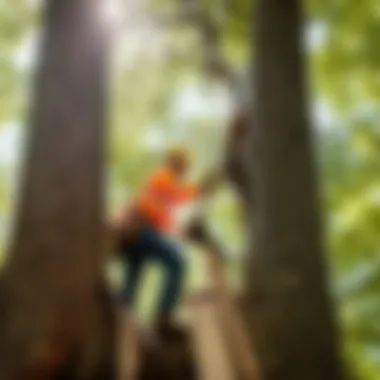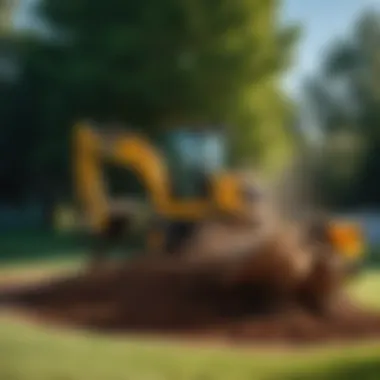Materials:
- Chainsaw: A high-quality chainsaw with a sharp blade for cutting through the tree efficiently.
- Safety gear: Essential safety equipment includes gloves, goggles, ear protection, and a hard hat to ensure personal safety.
- Rope and harness: To secure branches and control the direction of tree falls.
- Ax and hand saw: These tools are handy for smaller branches and detail work.
- Ladder: A sturdy ladder for reaching higher branches and areas of the tree.
- Tarp: To collect tree debris and make cleanup easier.
DIY Steps:
- Assess the tree: Determine the size, type, and condition of the tree to plan the removal process accordingly.
- Obtain any necessary permits: Check local regulations and obtain permits if required for tree removal in your area.
- Decide on the direction of tree fall: Choose the safest direction for the tree to fall considering obstacles and safety measures.
- Clear the area: Remove any obstacles, structures, or furniture around the tree to create a safe working space.
- Safely climb the tree (if needed): Use proper safety equipment when climbing the tree to assess branches and plan cuts.
Technical Aspects:
- Timing specifics: Choose the right time of year to remove the tree, considering factors like weather and tree health.
- Tools: Ensure you have the necessary tools, including a chainsaw, ax, hand saw, rope, and harness for safe and efficient tree removal.
- Critical techniques: Learn proper cutting techniques to avoid accidents and ensure the tree falls in the intended direction.
DIY Project Process:


- Cut smaller branches first: Start by trimming smaller branches before making cuts to the main trunk.
- Make a horizontal cut: Create a horizontal notch on the side of the tree where you want it to fall.
- Make a back cut: Cut through the opposite side of the tree, slightly above the horizontal notch to fell the tree in the desired direction.
- Remove the tree: Once the tree falls, cut it into manageable sections for disposal or further processing.
Troubleshooting Tips:


- If the tree starts leaning in a different direction, stop cutting immediately and reassess the situation.
- In case of a stuck chainsaw, never try to force it free; safely remove it and reset the cut.
- Avoid cutting multiple trees simultaneously as it can lead to accidents and unsafe working conditions.
Introduction


Understanding the Need for Tree Removal
Assessing the Reasons for Tree Removal
When it comes to assessing the reasons for tree removal, it is essential to consider various factors that may warrant the need to remove a tree from your yard. Whether the tree is diseased, posing a safety hazard, or affecting the overall aesthetics of your landscape, a thorough evaluation is crucial. By understanding the specific reasons behind tree removal, homeowners can make informed decisions to enhance the health and appearance of their outdoor environment.
Considering Safety and Aesthetics
Safety and aesthetics are paramount when it comes to tree removal. Prioritizing safety not only protects individuals involved in the removal process but also safeguards surrounding structures and landscapes. Additionally, considering the aesthetic impact of tree removal ensures that the final result aligns with your vision for the outdoor space. Striking a balance between safety considerations and aesthetic outcomes is key to achieving a successful tree removal project.
Preparing for Tree Removal
Gathering Necessary Tools and Equipment
Before embarking on a tree removal project, it is essential to gather the necessary tools and equipment required for the job. These may include chainsaws, safety gear, ropes, and pruning tools, among others. Having the right tools on hand ensures that the removal process progresses smoothly and efficiently, allowing for effective tree management.
Ensuring Proper Permits and Regulations
In addition to acquiring the appropriate tools, homeowners must also ensure compliance with local permits and regulations governing tree removal. Before initiating any removal activities, it is crucial to obtain the necessary permits and adhere to regulatory guidelines to prevent any legal repercussions. By staying informed about permit requirements and regulations, homeowners can navigate the tree removal process with confidence and compliance.
Important Safety Precautions
Wearing Protective Gear
When engaging in tree removal, wearing protective gear is non-negotiable. Helmets, goggles, gloves, and sturdy clothing are essential to safeguard against potential injuries during the removal process. Prioritizing personal safety through the use of protective gear promotes a secure working environment for all individuals involved in the project.
Clearing the Work Area
Clearing the work area is a critical safety precaution that helps eliminate hazards and obstacles that may impede the tree removal process. Removing debris, marking boundaries, and ensuring a clear path for tree felling are essential steps in maintaining a safe work environment. By clearing the work area effectively, homeowners can minimize risks and streamline the tree removal operation.
Steps for Tree Removal
Removing a tree from your yard is a crucial task that requires careful planning and execution. This section delves into the essential steps involved in the tree removal process to ensure a safe and efficient outcome.
After assessing the condition of the tree and determining the falling direction, the actual cutting techniques come into play, followed by the removal of the stump and roots. Each step is vital to the overall success of the tree removal process, emphasizing the importance of thorough planning and precise execution.
Assessing Tree Condition
Checking for Diseases and Pests
When assessing a tree's condition, checking for diseases and pests is crucial. This step helps in identifying any potential health issues that may affect the tree's stability and overall health. By examining the tree for common signs of infestation or disease, such as unusual spots on leaves or visible pests, homeowners can proactively address these issues before proceeding with the removal process.
Evaluating Structural Integrity
Evaluating the structural integrity of the tree is equally important as it determines the safety risks associated with its removal. Inspecting the trunk for signs of decay, cracks, or hollow areas can provide insights into the tree's stability. Understanding the structural integrity helps in choosing the appropriate cutting techniques and precautions to avoid accidents during the removal process.
Determine Falling Direction
Considering Surrounding Structures
Before felling a tree, evaluating the surrounding structures is imperative. Considering nearby buildings, power lines, and other obstacles helps in determining the safest direction for the tree to fall. By assessing the surroundings, homeowners can prevent potential property damage and accidents during the tree removal.
Utilizing Proper Cutting Techniques
Utilizing the right cutting techniques plays a significant role in ensuring a smooth and controlled tree removal process. Proper cutting methods not only facilitate the tree's safe descent but also minimize the impact on the surrounding environment. By employing precision cuts and utilizing advanced tools, homeowners can enhance the efficiency and safety of the tree removal.
Cutting Techniques
Top Down Cutting Method
The top-down cutting method involves removing the upper sections of the tree first before proceeding to the lower parts. This technique allows for better control over the tree's descent and helps in managing potential hazards during the cutting process. By gradually working from the top, homeowners can safely dismantle the tree while minimizing risks associated with falling debris.
V-Notch Cutting Technique
The V-notch cutting technique is an advanced method that involves creating precise notches in the tree trunk to control its falling direction. By strategically cutting v-shaped grooves on the tree, homeowners can dictate the angle at which the tree will topple, ensuring a targeted and safe descent. This technique requires skill and attention to detail but offers enhanced control over the tree removal process.
Removing Stump and Roots
Digging Out the Stump
After felling the tree, removing the stump is the final step in the tree removal process. Digging out the stump involves using specialized tools and equipment to uproot the remaining base of the tree. By carefully excavating the stump and its roots, homeowners can clear the area for future landscaping projects and eliminate any remnants of the removed tree.
Treating Surrounding Soil
Once the stump is removed, treating the surrounding soil is essential to promote healthy growth in the area. Adding organic matter, fertilizer, or other soil amendments can improve the soil's quality and prepare it for new vegetation. By nourishing the soil and restoring its nutrients, homeowners can rejuvenate the landscape and create a fertile environment for future plants or trees.
Post-Removal Care
In the process of tree removal, the post-removal care is a critical phase that ensures the yard is left in a safe and aesthetically pleasing condition. It involves two main elements: cleaning and disposal, and land restoration. Proper post-removal care not only enhances the overall appearance of the yard but also contributes to environmental sustainability.
Cleaning and Disposal
Clearing Debris:
Clearing debris is a crucial aspect of post-removal care as it involves the removal of tree branches, leaves, and any other leftover residue from the removal process. This step is essential to prevent any potential hazards or obstructions in the yard, ensuring a safe environment for occupants and visitors. Clearing debris also helps in promoting healthy growth for the surrounding vegetation by eliminating unnecessary organic matter that could impede growth.
Eco-Friendly Disposal Methods:
Utilizing eco-friendly disposal methods is a responsible choice that not only benefits the environment but also aligns with sustainable practices. These methods involve recycling tree debris by mulching or composting, reducing waste sent to landfills, and minimizing the carbon footprint of the removal process. By embracing eco-friendly disposal methods, homeowners contribute to preserving the ecosystem and fostering a greener environment for future generations.
Land Restoration
After the tree removal process, land restoration plays a vital role in rejuvenating the yard and promoting its resilience. Land restoration mainly involves planting new vegetation and replenishing soil nutrients to enhance soil quality and support healthy plant growth.
Planting New Vegetation:
Planting new vegetation is crucial for revitalizing the landscape and filling in the empty space left by the removed tree. Selecting suitable plants for the specific environment and climate ensures successful growth and adds to the visual appeal of the yard. It also encourages biodiversity and attracts beneficial insects, contributing to a balanced ecosystem.
Replenishing Soil Nutrients:
Replenishing soil nutrients is essential to maintain soil fertility and provide ample nourishment for new plantings. Adding organic matter such as compost or mulch helps in improving soil structure, retaining moisture, and supporting beneficial microbial activity. By replenishing soil nutrients, homeowners ensure the long-term health and vitality of their yard, creating a thriving landscape for years to come.
Conclusion
Final Checks and Assessment
Ensuring Safety Measures
When it comes to Ensuring Safety Measures, precision and attention to detail are key components that contribute significantly to the overall safety of the tree removal process. One of the key characteristics of Ensuring Safety Measures is the integration of proper safety protocols and equipment to minimize risks and potential hazards. This approach ensures a safe working environment for both the individuals involved in the tree removal and the surrounding property.
The unique feature of Ensuring Safety Measures lies in its proactive nature, emphasizing prevention rather than reaction. By implementing comprehensive safety measures, such as the use of personal protective equipment and following industry standards, homeowners can mitigate potential dangers and accidents during tree removal. While it adds an extra layer of preparation and caution, the advantages of prioritizing safety measures far outweigh any disadvantages, making it an indispensable choice throughout this article.
Surveying the Yard Post-Removal
Surveying the Yard Post-Removal is a critical aspect that contributes to the overall success and satisfaction of the tree removal process. This step involves inspecting the area where the tree stood to ensure that no debris or potential hazards remain after the removal. By highlighting key characteristics, such as meticulous examination and attention to detail, homeowners can effectively survey the yard post-removal to guarantee a clean and safe environment.
One of the unique features of Surveying the Yard Post-Removal is its role in preventing future issues or complications that may arise from the tree removal. By conducting a thorough survey, homeowners can identify any areas of concern, such as potential damage to the surrounding landscape or hidden debris. While the process may require time and effort, the advantages of post-removal yard inspection provide invaluable peace of mind and assurance that the job was completed effectively.
Professional Consultation
Seeking Expert Advice if Necessary
Seeking Expert Advice if Necessary adds a layer of expertise and credibility to the tree removal process, ensuring that homeowners make informed decisions based on expert recommendations. By highlighting key characteristics, such as industry knowledge and experience, seeking professional consultation proves to be a beneficial choice for homeowners looking to navigate complex tree removal scenarios.
The unique feature of Seeking Expert Advice lies in its ability to offer personalized recommendations and guidance tailored to the specific needs of each tree removal project. Experts can provide insights on tree conditions, removal techniques, and potential challenges, ultimately assisting homeowners in making well-informed decisions. While there may be associated costs with professional consultation, the advantages of tapping into expert knowledge far outweigh any potential disadvantages, making it a valuable investment in ensuring the success of the tree removal process.
Understanding Long-Term Implications
Understanding Long-Term Implications is crucial in planning for the aftermath of tree removal, as it involves considering the future impact of the removal on the yard and surrounding environment. By highlighting key characteristics, such as foresight and planning, understanding long-term implications proves to be a wise choice for homeowners seeking to maintain the health and aesthetics of their property post-removal.
The unique feature of Understanding Long-Term Implications lies in its emphasis on sustainability and environmental consciousness, urging homeowners to replant and restore the yard to its former glory. By addressing long-term implications early on, homeowners can avoid potential issues such as soil erosion, loss of biodiversity, and landscape deterioration. While it requires careful consideration and long-term commitment, the advantages of planning for the future health of the property are substantial, offering enduring benefits for both the homeowner and the environment.





